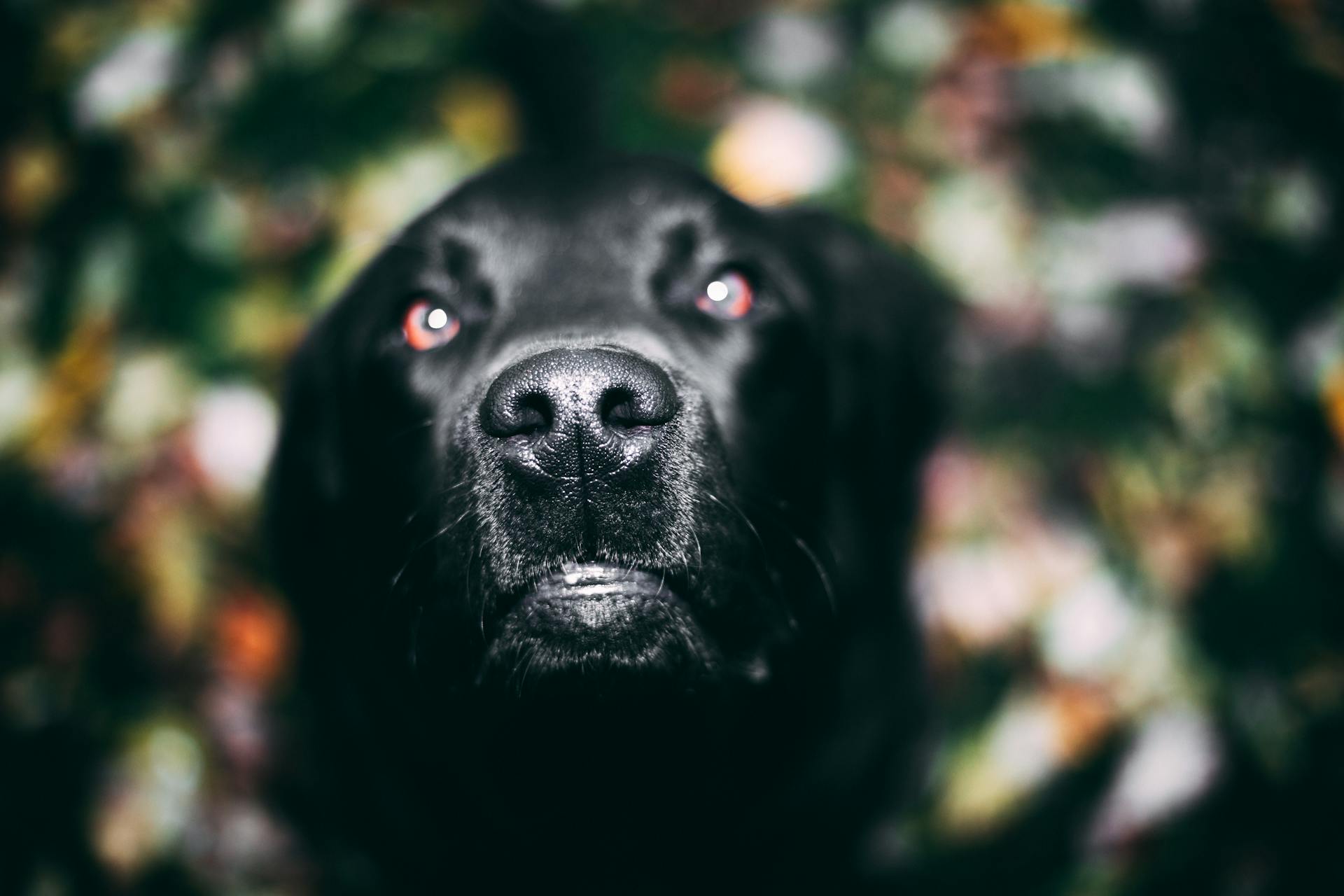
If your furry friend is suffering from allergies, you're not alone. Many dogs experience skin irritation, itching, and digestive issues due to environmental allergens.
Some common allergens include pollen, dust mites, and certain foods, which can trigger allergic reactions in dogs.
Essential oils can be a natural and effective remedy for alleviating allergy symptoms in dogs. For example, lavender oil has been shown to reduce anxiety and stress in dogs, which can be beneficial for those with allergies.
By using essential oils, you can help reduce your dog's exposure to allergens and promote overall health and well-being.
What You Need to Know
Essential oils can be a game-changer for dogs with allergies.
Lavender oil, in particular, has been shown to have a calming effect on dogs, reducing anxiety and stress related to allergies.
Some essential oils, such as tea tree oil, have antimicrobial properties that can help combat skin infections and hot spots caused by allergies.
Olive oil, when used topically, can help soothe and moisturize dry, itchy skin.
Curious to learn more? Check out: How to Help Dogs with Skin Allergies
Diagnosing Allergies
Diagnosing allergies in dogs requires a definitive diagnosis before using essential oils for treatment. This means getting a clear understanding of what's causing your dog's symptoms.
To start, your veterinarian may take skin scrapings from affected areas to complete a cutaneous cytology, which is a microscopic examination of skin cells to look for issues like mites, yeast infections, or other signs of disease.
A definitive diagnosis is crucial because using soothing solutions on the skin is only minimally helpful if the issue is a food allergy or a yeast or bacterial infection instead.
Blood work may be performed to ensure the oil is not being absorbed by the body and causing a serious reaction internally.
Causes of Allergies in Dogs
Allergies in dogs can be caused by a variety of things, including food and environmental factors.
Atopy, or genetic predisposition to allergies, is a common cause of allergies in dogs. This means that if your dog has a family history of allergies, they're more likely to develop an allergy themselves.
Foods such as beef, dairy, and wheat are common culprits behind food allergies in dogs. These ingredients can cause an immune reaction, leading to symptoms like itching and digestive issues.
Environmental allergies, on the other hand, can be triggered by things like pollen, dust mites, and mold. If your dog is exposed to these allergens regularly, they may start to develop an allergy over time.
Some breeds, such as West Highland White Terriers and Scottish Terriers, are more prone to allergies due to their genetic makeup.
Symptoms of Allergies in Dogs
Symptoms of allergies in dogs can be quite varied, but some common signs include runny nose and runny eyes.
If your dog is experiencing allergies, you might notice itchy skin or dry, flaky skin.
In severe cases, allergies can lead to poor skin conditions and hair loss.
Here are some common symptoms of allergies in dogs:
- Runny nose
- Runny eyes
- Itchy skin
- Dry, flaky skin
- Poor skin conditions
- Poor hair coat
- Hair loss
- Bumps/rash
- Hives
- Obsessive licking/chewing of feet
- Inflamed, red paw pads
- Respiratory issues
Diagnosis Methods
To diagnose allergies in dogs, your veterinarian may take skin scrapings from affected areas to complete a cutaneous cytology, which is the microscopic examination of the skin cells to look for issues like mites, yeast infections, and other signs of disease.
A complete blood count (CBC) and chemistry panel may be performed to indicate how the internal organs are functioning and rule out other possible causes of the symptoms.
Your veterinarian may also perform a urinalysis for further evaluation of kidney function if necessary.
In some cases, a small amount of the suspected allergen or allergens may be injected into the skin to confirm which substance the patient is allergic to.
Bicom testing, intradermal testing, and serum allergy investigation may be considered in the diagnosis, but the choice of testing will depend on the severity of the allergy and the expense of the testing.
Blood work may be performed if your veterinarian suspects a cause other than the essential oil or to ensure the oil is not being absorbed by the body and causing a serious reaction internally.
Intriguing read: Blood Test for Dogs with Allergies
Treatment Options
Administering essential oils to your dog can be done through a diffuser, which heats the oil and causes it to evaporate for inhalation.
Thirty minutes in the room with the diffused essential oil is generally sufficient for treatment.
Diluting essential oils with olive or coconut oil, or mixing with pet-safe lotion or glycerine, is a safe way for topical application.
This method should be massaged into an area of sparse fur, but be cautious as dogs tend to lick themselves and topical applications often become ingestions.
If your veterinarian recommends it, a mild soap or dish detergent bath can be used to remove the oil from your dog's skin in case of a skin reaction.
A bath can also be effective in removing the aromatic fragrance if your dog is suffering from a runny nose, eyes, or similar symptoms.
Broaden your view: Oatmeal Bath for Dogs with Allergies
Safely Using Essential Oils
Using essential oils for allergies in dogs requires careful consideration. The oils are powerful and can cause adverse effects if not used properly.
First and foremost, make sure to use therapeutic grade oils from reputable companies and verify their quality before using them. This will help minimize the risk of contamination.
It's also essential to be aware of your dog's sensitivity to essential oils. Animals have an acute sense of smell, so it's best to use diluted oils and provide an escape route. If your dog shows signs of intolerance, remove the oil immediately.
To avoid sensitivity and organ toxicity, don't use essential oils for more than two weeks at a time. A rest period is essential to allow your dog's body to recover.
If you're new to using essential oils, start with small amounts and gradually increase as needed. One drop of essential oil diluted in 50 drops of a pure carrier oil, such as grapeseed oil, is usually a good starting point.
For example, a recipe that combines 5 drops of myrrh, 5 drops of helichrysum, and 5 drops of copaiba with 2ml of carrier oil can be a safe and effective pain reliever for your pets.
Here's a quick reference guide to help you choose the right essential oil for your dog's allergies:
Remember, more is not better when it comes to essential oils. Always start with small amounts and gradually increase as needed.
Natural Remedies
Using natural remedies can be a game-changer for your furry friend's allergy skin issues.
Animal Scents Ointment is a must-have in your first aid kit, and it can be used to soothe irritated skin and wounds.
You can also mix additional oils into this ointment, such as one drop or more of an essential oil per tablespoon of ointment, to customize it for your dog's specific needs.
Fractionated coconut oil can be used to dilute the ointment further and apply it to larger areas of your dog's skin.
This ointment is also great for repelling biting insects and healing any scabs or wounds at the same time.
ClaraDerm is another amazing pre-made essential oil blend that's safe for dog's skin, containing coconut oil, myrrh, tea tree, lavender, frankincense, roman chamomile, and helichrysum.
It's a great formula to help treat yeast infections, especially around irritated anal glands, on itchy paw pads, and anywhere else there are secondary skin irritations and infections.
However, if your dog has dry skin, ClaraDerm may not be the best choice due to the coconut oil.
You can use a gentle cleaner like dilute castile soap or Thieves cleaner to clean the area or wounds before applying any ointments or essential oils.
It's also a good idea to test a small area first to make sure your pet tolerates the remedy or diffuse the essential oils in a water diffuser in an open room.
Recovery and Prevention
Using essential oils can help alleviate allergies in dogs, but it's also crucial to focus on prevention.
To prevent allergies, consider using a HEPA air purifier, which can remove 99.97% of particles as small as 0.3 microns from the air.
Dietary changes, such as adding omega-3 fatty acids and probiotics to their food, can also help reduce inflammation and support the immune system.
Recovery from Allergies in Dogs
Recovery from allergies in dogs can be a challenge, but with the right approach, your furry friend can feel better in no time. One thing to keep in mind is to clean the area or wounds first before applying any remedies.
Thieves cleaner can be diluted and used to wash any wounds, making it a great option for skin irritations caused by allergies. A gentle cleaner like dilute castile soap is also a safe choice.
After cleaning the wound or irritated skin, applying a wound healing ointment like Animal Scents ointment can be very effective. You can also make your own ointment by mixing 5 drops of lavender and 5 drops of helichrysum in a 1 tablespoon of manuka honey.
Remember, more is not better with essential oils, so be sure to use the right dosages. Always test a small area first to ensure your pet tolerates the remedy, and consider working with someone who can guide you through the process.
Consider reading: Can Dogs Use Human Eye Drops for Allergies
Preventing Future Allergies
Breastfeeding for at least four months can reduce the risk of allergies in infants.
Research suggests that introducing solid foods at the right time, around six months, can also help prevent allergies.
A study found that babies who started eating solid foods before six months were more likely to develop allergies.
Exposure to a variety of foods during the first year can help prevent allergies, but it's essential to introduce them one at a time.
The hygiene hypothesis proposes that a lack of exposure to certain microorganisms in childhood may contribute to the development of allergies.
In countries where children are exposed to more microorganisms, such as in rural areas, the prevalence of allergies is lower.
A study found that children who grew up on farms had a lower risk of developing allergies.
Frequently Asked Questions
What is the best oil for dogs that are itchy?
For itchy dogs, coconut oil is a recommended topical supplement to strengthen the skin barrier and reduce itchiness, with minimal risk of harm when used under a vet's guidance. Consult with your vet to determine the best approach for your dog's specific skin needs.
Can I put essential oils directly on my dog?
No, it's not recommended to apply essential oils directly to your dog's skin or fur due to potential health risks. Instead, consult with a veterinarian or a certified aromatherapist for safe and effective ways to use essential oils around your dog
Sources
- https://www.herbsmithinc.com/5-step-guide-to-allergy-relief-for-dogs/
- https://wagwalking.com/condition/essential-oils-for-allergies
- https://www.dogsnaturallymagazine.com/essential-oils-canine-allergies/
- https://wagwalking.com/condition/doterra-allergies
- https://thenaturalpetdoctor.com/essential-oils-to-soothe-dogs-skin/
Featured Images: pexels.com


